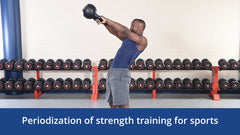Periodization of strength training for sports
BY TUDOR O. BOMPA, PhD, AND CARLO BUZZICHELLI, AUTHORS OF PERIODIZATION OF STRENGTH TRAINING FOR SPORTS
FEBRUARY 2023
“Strength training” seems to be everything to everybody; it’s often confused with fitness training, bodybuilding, or even weightlifting. The purpose of this book is none of these; rather, it concentrates on the specifics of strength training for sports. Three essential elements distinguish this book from all others on the market:
- A periodization planning component is included. If you want to be successful in training, you have to also be well organized and plan effective periodized training. Periodization is a term that’s unfamiliar to some people. It refers specifically to how to organize and plan your year of training into several periods of time. Periodization uses periods of time, or training phases, such as the preparatory (preseason) phase and the competitive phase. Examples of periodization of strength training for each phase of the annual plan are offered in specific parts of the book.
- Strength training for sports, a specialized type of sport-specific strength training, is discussed throughout the book. A clear distinction between fitness and strength training for sports is made. While fitness training has the purpose of keeping people active and healthy, the purpose of strength training for sports is to improve athletic performance. Strength training for sports is intended to increase sport-specific strength, power, speed, and agility to the highest level possible and, as a result, help the athletes win the medal they’re competing for.
- Sports training has a physiological objective. Throughout their many months of training, athletes perform specific training that targets the heart, lungs, and neuromuscular system in order to improve athletic capacity and, as a result, improve sports performance. The development of sport-specific strength to the higher level will directly help an athlete improve power, speed, and agility—qualities that are essential for achieving the best athletic results.
Exercise Selection for Maximum Athletic Performance
There is another big difference between fitness and sports training: Fitness instructors expose their clients to as many exercises as possible. In sports, on the other hand, we target sport-specific exercises that best involve the prime movers—the muscles performing specific technical skills—and train them to increase strength and improve performance.
Periodization of Strength Training for Sports offers fresh perspectives on the selection of exercises. We do not just offer our opinions regarding which exercises are best and which are least effective. The real arbiter in this regard is science. We use scientific findings to promote effective exercise selection.
Let us share with you an example. If you visit a gym, you’ll see that squats are one of the most popular exercises. Some instructors might say, “Do squats! Squats will increase your legs strength because they target the quadriceps muscles and, as a result, will make you faster!” This is not correct. The actual muscle that makes you faster and more agile is not the quadriceps but rather the gastrocnemius muscle (see figure 1). Let’s examine what science is saying about the two muscles. The gastrocnemius is the highest producer of force and, as a result, it can generate the highest speed during sprinting, agility, and takeoff actions.

Figure 1. The gastrocnemius muscle: the engine of sprinting and agility.
The gastrocnemius muscle is the powerhouse of sprinting, jumping, and agility actions. Keep in mind that the gastrocnemius provides more than 50% of the force necessary to produce a forceful push-off during sprinting, whereas rectus femoris (part of the quadriceps) provides only 18% (Enoka 2015). Similar findings were also reported by other researchers. Ferris and Hawkins (2020) reported that the gastrocnemius contributes 40% of the force produced by calf muscles during sprinting. This contribution is even higher when the knee angle is higher (closer to full extension, between 75 and 90 degrees).
When you do squats, you are taking that time away from exercises that would target the prime movers of sprinting, jumping, and agility: the gastrocnemius and soleus muscles.
Why is the gastrocnemius such a powerful muscle? It consists of 1,120,000 muscle fibers and 1,934 innervations numbers, the number of muscle fibers stimulated by a motor neuron that can be recruited to generate force, speed, and agility (Enoka 2015). The higher the number of muscle fibers involved in action, the higher the force of the leg push-off against the ground, and the greater the speed, jump, and agility. How about the quadriceps? It has only 22,000 muscle fibers and 5 innervation numbers (Enoka 2015).
|
Muscle |
Gastrocnemius |
Quadriceps |
|
Number of muscle fibers |
1,120,000 |
1,934 |
|
Innervation numbers |
22,000 |
5 |
Figure 2. A comparison of the effectiveness of the gastrocnemius and the quadriceps.
Please also consider that ground reaction force for gastrocnemius is 940.75 N, or 95.8 kg/221.2 lb (Richards et al. 2013). Ground reaction refers to the force applied against the ground by an athlete during sprinting or other athletic actions. The higher the force, the higher the ground reaction and, as a result, the higher the velocity.
References
Enoka, R.M. 2015. Neuromechanics of human movement. 5th ed. Champaign, IL: Human Kinetics.
Ferris, R.M., and D.A. Hawkins. 2020. Gastrocnemius and soleus muscle contribution to ankle plantar flexion torque as a function ankle and knee angle. Sports Injr Medicine. July 20, 2020.
Richards, J., E. Chohan, and R. Erande. 2013. Biomechanics. Edinburg: Elsevier.

Latest Posts
- A Guide for Fitness Professionals: Dr. Barbara A. Bushman on Fitness Professional’s Handbook, Eighth Edition
- Single-leg vs. double-leg training for athleticism
- Fountain of youth for athleticism: Lifting, sprinting, or jumping?
- Cause-and-effect connection between physical activity and specific outcomes
- The science of getting stronger without weights
- BODYBUILDING ANATOMY


